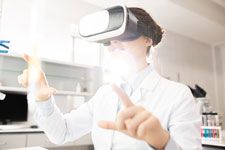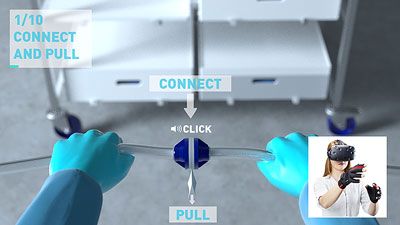Visualization Enhances Facility Design
Visualization using virtual and mixed reality can aid with biopharma manufacturing facility design and training.
Seventyfour - Stock.adobe.com

As we witness a health revolution with the development of biological medicines, biopharmaceutical companies are still facing major challenges around how to manufacture these drugs and get them to market as quickly and safely as possible.
The wide range of new and emerging product types, such as cell-based therapies, gene therapies, antibody-drug conjugates (ADCs), monoclonal and stripped-down antibodies, RNA interference drugs, and live microbe therapeutics, all require very different manufacturing capability and capacity than traditional pharmaceuticals. Moreover, as the biopharmaceutical industry comes of age, current blockbuster medicines are, or will soon go, off-patent. This means there is a growing need to also increase capacity to manufacture biosimilars.
Biopharmaceutical companies are continuously demanding new and improved bioprocessing technologies to reduce costs, increase efficiencies, and bring treatments to market faster. Year over year, companies spend and invest more on their R&D, new technologies, bioprocessing capacity, staff, and other infrastructure.
To meet the growing demand for manufacturing capacity and address the changing needs of an evolving industry, digital technologies are becoming increasingly important to biopharmaceutical manufacturing companies. One area of innovation is the virtual design of manufacturing facilities.
When constructing a new biomanufacturing facility, there is an ever-increasing number of bioprocessing options. Having to design, build, and operate a facility before knowing whether the right processes, equipment, and workflows have been chosen, adds considerable risk, especially given significant capital expenses. Advanced visualization, mixed reality (MR), and virtual reality (VR) tools are now being used to inform planning and implementation decisions and enable engineers and designers to plan a new facility, in minute detail, long before construction begins.
Simulation enables biopharmaceutical manufacturers to identify and resolve problems before they occur. It also creates an opportunity for those who will be working in the facility to virtually walk through the infrastructure: to understand the space, get used to the instrumentation arrangements, and build their knowledge of the full biomanufacturing process. They can identify any practical shortcomings and feed this back to those managing the design process, thus enabling them to select optimal instruments, tools, and processes to maximize uptime and gain efficiencies.
Using VR in facility design
Servier, an independent international pharmaceutical company, used a VR tool to design, plan, and implement one of its new biomanufacturing facilities. Pall and digital transformation specialists OUAT! worked together to develop the tool using a virtual simulation platform (HakoBio, Pall), which enabled Servier to design its new facility in a virtual, three-dimensional (3D) model at the start of the project.
The virtual facility was used to give the team a real sense of the layout and test whether there was sufficient space to safely and comfortably manipulate the equipment when needed. These tests allowed the designers and engineers to refine the design of the space and ensure that scientists and technicians would not be crowded when working in the space, such as when exchanging disposable, single-use components like bioreactors.
They also looked at how well the equipment would work in an end-to-end bioprocess. The virtual visualization was used to optimize the location of each piece of equipment and maximize usage over time by testing different configurations and combinations to find the best solution. Using a Gantt chart to show the output from a digital twin of a viral vector gene therapy bioprocess, spatial issues or bottlenecks could be identified, which would improve the overall uptime of each unit operation. Spatial issues are particularly critical for manufacturing suites that incorporate single-use systems, where the interconnectedness of each piece of equipment requires careful planning to fit most effectively with operator workflows.
Using this type of digital twin approach to fully visualize a future manufacturing facility, biopharmaceutical companies can find the best layout and use of equipment and optimize and reduce when possible the size of their overall facility. Supported by VR-based information, these decisions were made more quickly and earlier in the design process, avoiding potentially costly issues later and accelerating construction of both processes and facilities.
Tackling the skills shortage
There is a shortage of skilled staff in the biopharmaceutical industry, which is affecting current and future capacity and production. In 2017, more than 50% of bioprocessing facilities experienced capacity problems due to difficulties hiring certain operations staff (1). This demand for staff is set to increase as the biopharmaceutical industry continues to grow, despite the move toward more automation and single-use components.
Increasingly, VR and MR technologies are being used for training, providing employees with a 3D virtual space in which to learn and practice bioprocess design skills. Handling equipment virtually in situ means people can “learn by doing” without having to be physically present in a biopharmaceutical facility or needing access to equipment that may not be easily available (see example shown in Figure 1). In this way, VR offers a means of tackling one of the biggest challenges faced by those studying at university, as well as those already in employment-not to mention giving learners greater control and flexibility over how, when, and where they learn.
Figure 1. Virtual reality or mixed reality can be used for training.Figure is courtesy of the author.

There is also an important safety aspect. Learning in environments that contain hazards and that tend to be stringently controlled, such as manufacturing suites with biosafety levels (BSLs) of 2 or higher, can be difficult. VR allows training providers to create a “digital twin” model that gives safe access to these environments.
Accessibility, too, can be transformed by the use of VR. Trainers no longer need to be physically present, meaning learners-and more of them-can access experts and key opinion leaders easily and more frequently. From a language perspective there are benefits, too, where experts can provide training in a virtual environment with quick, cost-effective translation support for international audiences. Advances in natural language processing using artificial intelligence technologies means verbal translations will soon become instantaneous, further enabling the globalization of training programs for employees and students around the world.
Perhaps most importantly, VR offers an immersive experience that can rarely be replicated in a classroom environment. Nothing can replace the skills you gain from “learning on the job” in a real facility-but being able to see the equipment, the process, and the layout in a virtual world goes a long way to bring theory to life for those starting out in their careers in bioprocessing.
Meeting patient needs
Digital tools inform decisions, improve bioprocesses, and enable specialized training in a way that supports and sustains biopharmaceutical industry growth, and we’re only seeing the beginning of this remarkable trend. As VR and MR in biopharma manufacturing design becomes increasingly prevalent and technologies continue to improve, medicines will make it to market faster. As an industry, we must embrace these innovative solutions. It will require focus, innovation, and investment, but it will be vital in manufacturing improvements and in providing patients worldwide with medicines they need, at a cost they
can afford.
Reference
1. E. Langer and R.A. Rader, “Demand for Efficiency Spurs Bioprocessing Innovation,” PharmTech.com (Oct. 4, 2017).
About the author
Nicole Fontourcy is head of Visualization Technology, Pall Corporation.
Article details
Pharmaceutical Technology
Vol. 43, No. 12
December 2019
Pages: 32-34
Citation
When referring to this article, please cite it as N. Fontourcy, “Visualization Enhances Facility Design,” Pharmaceutical Technology 43 (12) 2019.

Pharmaceutical Tariffs Are Imminent: How Industry is Bracing for Impact
April 16th 2025On April 14, 2025, the Trump Administration launched a national security-driven investigation into pharmaceuticals, a move that will likely result in tariffs being placed on pharmaceutical drugs, ingredients, and other components that are imported from outside of the United States.
Drug Solutions Podcast: A Closer Look at mRNA in Oncology and Vaccines
April 30th 2024In this episode fo the Drug Solutions Podcast, etherna’s vice-president of Technology and Innovation, Stefaan De Koker, discusses the merits and challenges of using mRNA as the foundation for therapeutics in oncology as well as for vaccines.